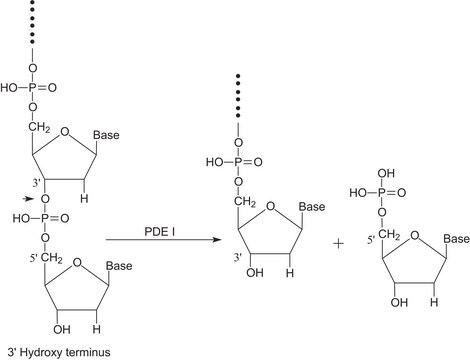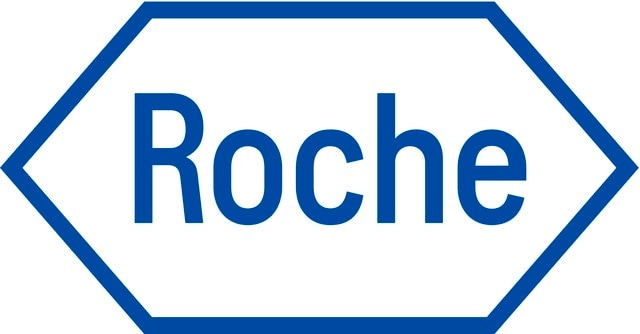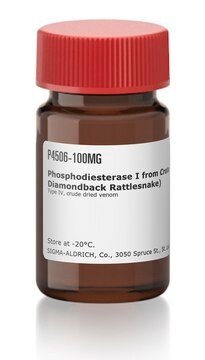추천 제품
생물학적 소스
Penicillium citrinum
Quality Level
양식
lyophilized powder
특이 활성도
≥200 units/mg protein (E1%/280, 3′-5′-Phosphodiesterase)
secondary activity
≥1,000 units/mg protein 3′-nucleotidase
분자량
42-50 kDa
포장
vial of ≥250 units (using RNA substrate)
기술
DNA extraction: suitable
DNA purification: suitable
적합성
suitable for molecular biology
응용 분야
cell analysis
저장 온도
2-8°C
유사한 제품을 찾으십니까? 방문 제품 비교 안내
일반 설명
Nuclease P1 is one of the most commonly known single-strand specific nucleases in molecular biology; Nuclease P1 is a single stranded specific endoduclease (of ssDNA or ssRNA). Nuclease P1 can also cleave single-stranded regions in double-stranded nucleic acids.
Nuclease P1 from Penicillium citrinum is a zinc-dependent endonuclease that exhibits increased activity in the presence of low concentrations of urea. Nuclease P1 selective activity has found useful applications in studies on nucleic acid structure.
Nuclease P1 from Penicillium citrinum is a zinc-dependent endonuclease that exhibits increased activity in the presence of low concentrations of urea. Nuclease P1 selective activity has found useful applications in studies on nucleic acid structure.
애플리케이션
- Nuclease P1 cleave of single stranded DNA or RNA to 5′ mononucleotides
- Nuclease P1 supports DNA damage and modification research
- Nucleic acids base composition and structural analysis can be done by Nuclease P1
- Nuclease P1 has historically been used for the industrial production of 5′-mononucleotides from yeast RNA.
- Removal of nucleic acids through protein purification can be done by Nuclease P1
- Nuclease P1 is a key reagent for the development of methods for studies involving t-RNA dependent amino acid biosynthesis and t-RNA dependent trans-amidation
- Nuclease P1 from Penicillium citrinum has been used in a study to assess crystal structures using ammonium sulphate or polyethylene glycol 4000 as a precipitating agent.
- Nuclease P1 was used in a study to investigate a method for the direct sequence analysis 20-25 nucleotides from the terinini of 5′ or 3′ end group labeled RNA.
- Nuclease P1 is used to improve the sensitivity of a 32P-labeling method for the detection of DNA adducts.
The enzyme has an optimal temperature of approximately 70 °C, but for a long incubation, a temperature below 60 °C is more suitable. It is stable in the pH range of 5 - 8.
생화학적/생리학적 작용
Catalyzes the nonspecific endonucleolytic cleavage of single stranded DNA and RNA to yield nucleoside 5′-phosphates and 5′-phosphooligonucleotides. It does not appreciably degrade double-stranded nucleic acids, especially in the presence of more than 400 mM sodium chloride at pH 6.0.
특징 및 장점
Our highly active Nuclease P1 is tested for its 3′- 5′ - Phosphodiesterase Activity and 3′- Nucleotidase Activity and is the most active Nuclease P1 in the market
물리적 특성
A zinc dependent glycoprotein consisting of 270 amino acid residues. Molecular mass: 42-50 kDa.
단위 정의
3′-5′-Phosphodiesterase: One unit will liberate 1.0 μmole of acid soluble nucleotides from RNA per min at pH 5.3 at 37 °C.
3′-Nucleotidase: One unit will hydrolyze 1.0 μmole of orthophosphate from 3′-AMP per min at pH 7.2 at 37 °C.
3′-Nucleotidase: One unit will hydrolyze 1.0 μmole of orthophosphate from 3′-AMP per min at pH 7.2 at 37 °C.
신호어
Danger
유해 및 위험 성명서
예방조치 성명서
Hazard Classifications
Resp. Sens. 1
Storage Class Code
11 - Combustible Solids
WGK
WGK 3
Flash Point (°F)
Not applicable
Flash Point (°C)
Not applicable
개인 보호 장비
Eyeshields, Gloves, type N95 (US)
이미 열람한 고객
M V Reddy et al.
Carcinogenesis, 7(9), 1543-1551 (1986-09-01)
Exceedingly sensitive procedures are required to detect the presence of covalent DNA adducts in humans exposed to environmental genotoxicants because of low levels of such derivatives (1 adduct in 10(8)-10(10) DNA nucleotides). A 32P-postlabeling assay for detection and quantitation of
Enhancement of nuclease P1 activity in low concentration of denaturants
Gangadhara, K. and P. Gangadhara
Enzyme and Microbial Technology, 43, 7-7 (2008)
K Shanmugha Rajan et al.
Nucleic acids research, 47(14), 7633-7647 (2019-05-31)
The parasite Trypanosoma brucei, the causative agent of sleeping sickness, cycles between an insect and a mammalian host. Here, we investigated the presence of pseudouridines (Ψs) on the spliceosomal small nuclear RNAs (snRNAs), which may enable growth at the very
Fiona J Flett et al.
Nature communications, 9(1), 24-24 (2018-01-04)
Tyrosyl-DNA phosphodiesterase (Tdp1) is a DNA 3'-end processing enzyme that repairs topoisomerase 1B-induced DNA damage. We use a new tool combining site-specific DNA-protein cross-linking with mass spectrometry to identify Tdp1 interactions with DNA. A conserved phenylalanine (F259) of Tdp1, required
A Lahm et al.
Journal of molecular biology, 215(2), 207-210 (1990-09-20)
P1 nuclease, a zinc-dependent single-strand specific endonuclease from Penicillium citrinum, has been crystallized in three different space groups using either ammonium sulphate or polyethylene glycol 4000 as the precipitating agent. The crystals diffract to between 3 A and 2.2 A.
자사의 과학자팀은 생명 과학, 재료 과학, 화학 합성, 크로마토그래피, 분석 및 기타 많은 영역을 포함한 모든 과학 분야에 경험이 있습니다..
고객지원팀으로 연락바랍니다.









